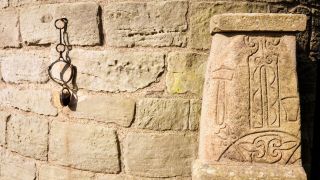Mysterious 'painted people' of Scotland are long gone, but their DNA lives on
A new look at eight skeletons from two Pictish cemeteries reveals that the enigmatic Picts weren't from afar, as medieval historians suggested, but that they had local roots.

Ancient DNA reveals that the Picts, the "painted people" of Scotland who fought off the Romans, weren't an enigmatic group that migrated from faraway lands. Instead, the Picts had local roots and were related to other Iron Age people in Britain, a new study finds.
An analysis of eight skeletons from two Pictish cemeteries, published Thursday (April 27) in the journal PLOS Genetics (opens in new tab), also suggests that the Picts did not organize their society around the female bloodline, contrary to what historians have long suggested.
The Picts, named from the Latin word "picti" for their reported use of body paint or tattoos, were a people who, in the third century A.D., resisted Roman rule and formed their own kingdom in northern Britain that lasted until around A.D. 900. There is very little written information about the Picts — much of what they wrote is in a unique and hard-to-translate script called ogham — and only a few of their settlements and cemeteries have been found.
The general lack of sources about the Picts and their way of life has led to numerous assumptions over the centuries. In the eighth century, during the early medieval period, for example, historians such as the Venerable Bede thought that the Picts emigrated from areas around the Aegean Sea or Eastern Europe and that they traced descent matrilineally, through the mother's side.
Archaeologists and historians have begun to tackle the "Pictish problem" in recent years, however, to develop a better understanding of this culture.
Related: Unknown symbols written by the lost 'painted people' of Scotland unearthed

In the newly published study, an international team of researchers extracted genetic information from eight human skeletons buried in two Pictish cemeteries — seven from Lundin Links and one from Balintore in modern-day Scotland.
"Lundin Links is one of the few excavated and well-dated monumental cemeteries from the Early Medieval (Pictish) period in Scotland," study co-author Linus Girdland Flink (opens in new tab), an archaeogeneticist at the University of Aberdeen, told Live Science in an email. According to past research (opens in new tab), the cemetery dates to A.D. 450 to 650 and holds the remains of a couple dozen people.
Human remains from the Pictish period are scarce, but the sandy soils at Lundin Links are more conducive to long-term preservation because they are less acidic than soil in other areas of Scotland. "This suggested to us that DNA may also be preserved and prompted further investigation," Girdland Flink said.
The team was able to extract a nearly complete genome, or set of a person's genes, from one skeleton from each of the two cemeteries. Both genomes, when compared with those of other ancient and modern groups from the British Isles, "reveal a close genetic affinity to Iron Age populations from Britain," the researchers wrote in the study, but show differences as well that are likely related to migration events and intermarriage with other groups.
From all seven Lundin Links skeletons, researchers were able to isolate mitochondrial DNA (mtDNA) information, which is passed from mother to child, allowing them to look into the assumption about matrilineal Picts. But none of the people whose mtDNA they analyzed shared immediate maternal ancestors, which means they "were unlikely to have been practicing matrilocality," according to the study.

The team also found that the Picts' genes persist in modern-day people who live in western Scotland, Wales, Northern Ireland and Northumbria (a medieval kingdom that now includes parts of northern England and southeastern Scotland), indicating that, even though their culture disappeared, their genes didn't.
"This paper is a welcome and overdue addition of Scottish samples to the growing literature on the paleogenetic study of the early medieval period," Adrián Maldonado (opens in new tab), a research fellow at National Museums Scotland who was not involved in the study, told Live Science in an email. "It is more evidence that the inhabitants of north-eastern Scotland were not some shadowy relic population, untouched by time."
It's a limitation that the study presents just two genomes from individuals in cemeteries 100 miles (160 kilometers) apart, Maldonado noted, but it's still a helpful step forward. "I eagerly await a larger dataset, including not just 'Picts' but their neighbors and descendants in later centuries, preferably joined with other proxies for mobility from stable isotope analysis," he said. "Only then will we have a clearer picture of the transformation of society in these critical post-Roman centuries."
Additional research on Pictish Scotland is already underway, according to a statement by study first author Adeline Morez (opens in new tab), who completed the work while at Liverpool John Moores University and is now a postdoctoral researcher at the French National Center for Scientific Research (CNRS), including excavation of new sites, chemical analysis of dietary habits and migration, and further DNA work.
Live Science newsletter
Stay up to date on the latest science news by signing up for our Essentials newsletter.
Kristina Killgrove is an archaeologist with specialties in ancient human skeletons and science communication. Her academic research has appeared in numerous scientific journals, while her news stories and essays have been published in venues such as Forbes, Mental Floss and Smithsonian. Kristina earned a doctorate in anthropology from the University of North Carolina at Chapel Hill and also holds bachelor's and master's degrees in classical archaeology.